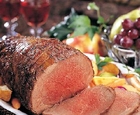|
French Entree Leg of Lamb Provençal Close your eyes and inhale the beautiful, earthy scents of Provence as this lamb roasts in your oven.
Rub/Marinade: cut small slits in lamb and insert garlic cloves, top and sides. Combine Herbes de Provence with remaining ingredients and rub into lamb, top and sides. Cover with plastic and refrigerate for 2-4 hours (some recipes say overnight, even up to 2 days!) Roast: preheat oven to 325. Place lamb on a roasting rack, spread with any remaining rub, and roast for 20 minutes per pound, or till an instant thermometer reads 150. Remove lamb from oven and let sit 15 minutes before carving. Serve with Ratatouille. ** * Herbes de Provence can be found on the spice shelf of most grocery stores. Or simply make your own combination, using equal parts of rosemary, marjoram, thyme, fennel seed, and savory. Some recipes include basil and bayleaf. ** You can also cook the lamb on top of thickly sliced potatoes and onions. Top vegetables with salt, pepper, minced garlic, and cover with chicken broth. Set the lamb directly on top of the potatoes and onions. |
Tips & Glossary Bouquet Garni: (boo-kay gar-nee) bundle of herbs tied together with string or wrapped in cheese cloth square; usually parsley, thyme, bay leaf, and peppercorns. Flavor is released during long cooking.Remove before serving. Chervil: (sher-vil) related to parsley but has a delicate anise flavor. Long cooking kills flavor, so add at the last minute. Cornichon (kor-nee-shon) teeny-tiny pickle, served with pates & smoked meats; found in specialty food stores. Fines Herbes: (feen-airb) mix of finely chopped herbs: parsley, chives, tarragon, & chervil. Not as strong as a bouqet garni. Buy it at most grocery stores. Fromage: (fra-mahj) Cheese! The French eat more than any nationality, 45 pounds per capita per year; and the country makes more cheeses than any other country, about 400. Herbes de Provence (airb-duh-pro-vonce): mix of dried herbs, usually thyme, rosemary, marjoram, basil, & bay leaf Can be found at most grocery stores. Mutarde: (moo-tard), mustard. Most famous: Nicoise Olive: (nee-swaz- oh-leev) small, purplish-black olive with a mellow, nutty flavor; used primarily in Salade Nicoise. The Picholine variety is a green, medium-sized olive with a light, nutty flavor. Roux: (roo) paste-like mix of melted butter and flour, into which liquid is gradually added. The basis of every classic French sauce.
|
Site by BOOM
![]()
LitLovers © 2024

